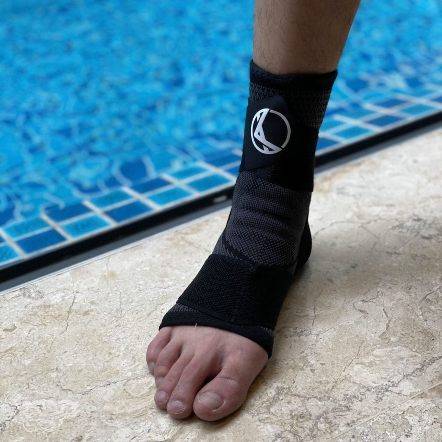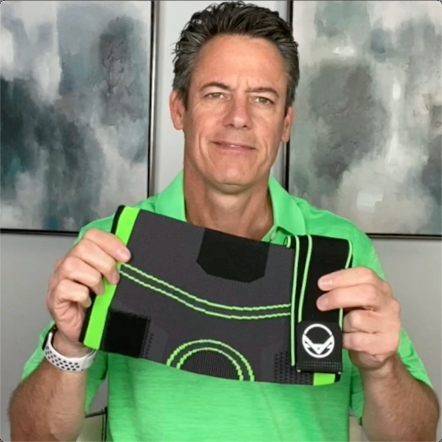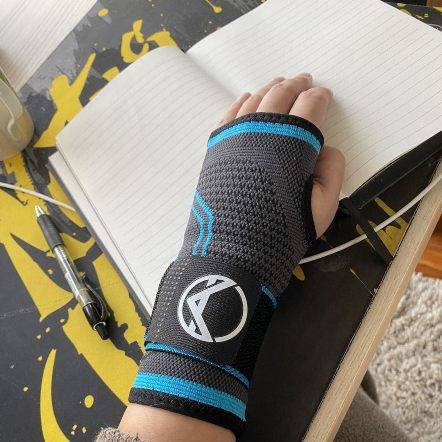
Finding Relief: Compression Socks for Ankle Swelling
june 29, 2023 | 3 Mins Read
TABLE OF CONTENTS
1. Do Compression Socks Reduce Swelling?
2. How Do Compression Socks Work for Swelling?
3. When to Wear Compression Socks for Ankle Swelling?
4. Are There Side Effects of Wearing Compression Stockings?
5. What Types of Compression Socks Are Good for Ankle Swelling While Sitting?
6.Are Compression Socks for Ankle Swelling After Surgery Effective?
Ankle swelling can be a bothersome and uncomfortable condition that affects many individuals. Whether it's caused by prolonged periods of standing or sitting, certain medical conditions, or post-surgery recovery, finding relief becomes a top priority. One solution that has gained popularity in recent years is the use of compression socks.
These specialized socks are designed to apply gentle pressure to the lower legs, promoting blood flow and reducing discomfort and swelling. In this article, we will explore the effectiveness of compression socks for ankle swelling, their mechanisms of action, when to wear them, potential side effects, and other techniques for managing ankle swelling.

Compression socks, specifically designed to apply pressure to the lower legs, play a crucial role in reducing discomfort and swelling by maintaining blood flow. These socks exert a gentle squeezing action on the legs, aiding in blood circulation and preventing fluid accumulation in the tissues. By promoting venous return, compression socks effectively alleviate pain, reduce swelling, and contribute to overall leg health.
If you are experiencing ankle swelling, wearing compression socks is highly recommended. These socks provide targeted compression in the feet, ankles, and lower legs, making them an excellent accessory for managing ankle swelling and leg cramps.
Swelling in the feet and ankles often occurs due to a build-up of pressure and fluid leaks in the capillaries, a condition known as Edema. But other medical conditions can also cause ankle swelling, such as:
In these cases, compression socks help to reduce the size of swollen veins and promote healthy blood flow.
Compression socks work through several specific mechanisms to improve ankle swelling. Here are some of the main ways compression socks help reduce ankle swelling:
Compression socks exert graduated pressure on the lower legs, with the highest pressure at the ankle and gradually decreasing towards the calf and knee. This compression helps to compress the superficial veins, promoting blood flow and preventing blood from pooling in the lower extremities. By improving venous return, compression socks facilitate the removal of excess fluid and waste products, thus reducing swelling in the ankles.
The application of external pressure by compression socks creates a gentle squeezing action on the tissues of the lower leg. This pressure assists in reducing the diameter of the superficial veins and lymphatic vessels, resulting in increased tissue pressure. The heightened tissue pressure helps to prevent the accumulation of fluid and promotes the reabsorption of interstitial fluid, reducing edema and swelling in the ankles.
Compression socks provide support to the muscles and ligaments of the lower leg. This support helps stabilize the tissues, minimizing excessive movement and microtrauma. By reducing tissue damage and inflammation, compression socks contribute to reducing swelling and discomfort in the ankles.
Swelling in the ankles can occur due to increased capillary filtration, allowing fluid to leak into the surrounding tissues. Compression socks exert pressure on the capillaries, reducing their diameter and limiting the leakage of fluid. By counteracting the capillary filtration process, compression socks help prevent the accumulation of fluid and subsequent ankle swelling.
The lymphatic system plays a crucial role in fluid balance and the removal of waste products from tissues. Compression socks assist in enhancing the movement of lymphatic fluid by exerting external pressure on the lymphatic vessels. This pressure promotes lymphatic flow and facilitates the drainage of excess fluid, reducing ankle swelling.
Venous stasis, or the impaired flow of blood in the veins, can contribute to ankle swelling. Compression socks aid in preventing venous stasis by facilitating the movement of blood against gravity. The graduated pressure exerted by the socks assists the calf muscles in pumping blood back toward the heart, improving venous return and reducing swelling in the ankles.
A study conducted in 2018 indicated that even a short period of wearing compression stockings can have positive effects on lower leg swelling. The study's findings supported the notion that compression stockings can be an effective treatment for ankle swelling.
Compression socks should typically be worn during the day and taken off before going to bed. It is advisable to put them on first thing in the morning. If you are prescribed compression stockings, you may receive at least two stockings or two pairs to wear on both legs. This allows you to alternate between stockings, wearing one while the other is being washed and dried.
Knowing when to wear compression socks is important for individuals who have poor circulation, are at risk of blood clots, or frequently experience swelling in the legs and feet.
While compression socks are generally safe, there are some potential side effects to be aware of:
Graduated compression socks are the most commonly recommended type for ankle swelling. These socks apply the highest amount of pressure at the ankle and gradually decrease the pressure towards the calf and knee. This design promotes blood flow, reduces swelling, and assists in pushing excess fluid out of the affected area.
Other types of compression socks, such as anti-embolism stockings and lymphedema compression garments, may be recommended for specific medical conditions or post-surgical recovery.
Yes, compression socks can be effective for ankle swelling after surgery. Compression socks provide therapeutic pressure to reduce inflammation and promote circulation in the affected area. They are also beneficial in providing support to the muscles and ligaments of the lower leg, thus reducing tissue damage and promoting recovery. Here are some of the benefits of wearing compression socks after surgery:

In addition to wearing compression socks, there are various lifestyle modifications and techniques that can help manage ankle swelling:
Selecting the best compression sock for swollen ankles requires careful consideration of various factors to ensure optimal effectiveness and comfort. Here are some key aspects to consider when choosing compression socks:
Graduated compression is typically recommended for ankle swelling. This means that the socks exert the highest pressure at the ankle and gradually decrease the pressure as they extend up the calf. This design promotes blood flow, assists in reducing swelling, and aids in pushing excess fluid out of the affected area.
Look for compression socks made from high-quality materials that are both durable and comfortable. Commonly used materials include nylon, spandex, and elastane, which provide the necessary elasticity and support. Additionally, moisture-wicking properties are beneficial as they help keep the feet dry and prevent excessive sweating.
Proper fit is crucial for compression socks to effectively reduce ankle swelling. Ensure that the socks are not too tight or too loose. It is recommended to measure your leg circumference and refer to the sizing chart provided by the manufacturer to find the right size. An ideal fit will provide sufficient compression without causing discomfort or restricting movement.
Look for compression socks with a comfortable toe and heel design. Reinforced or cushioned toes and heels can enhance overall comfort and durability, especially if you plan to wear the socks for extended periods.
While personal preferences may vary, several reputable brands and products have received positive user reviews for their effectiveness in reducing ankle swelling. One such brand is Koprez®, known for its quality compression socks designed for comfort and therapeutic benefits. Get your pair today!






References
Author

Claire Evans worked as the content marketing manager at Koprez. Claire combined a background of writing and editing, marketing, and patient education to best serve consumers, fitness enthusiasts, athletes, and anyone who relies on the Koprez brand for helpful information.
Koprez® Featured Products


"I sprain my wrist super often, so I decided to try out this sleeve. This is game-changing! I've been using it for a while now, and my wrists feel amazing. I haven't gotten in any injuries since using it too. It just makes my wrists feel so supported."
Alexis A.


"Use this for my boxing training. It is a very comfortable brace and does not move out of position during skipping ropes and sparring sessions. I use it while running too. Probably the best brace I've purchased throughout the years. It is very flexible. Makes me look like a pro! :)"
Samuel L.


"I've just got back to running after a couple of years of being plagued by injury. These compressions socks are helping give me peace of mind while I build up my distance again. They are the perfect level of compression, super comfy, and very high quality. Feel great while on a run, and looks great in the orange colour I have!"
Dave R.


"I have a weak ankle, and the Koprez ankle sleeve has been a lifesaver. Wear it every day. Super breathable and comfortable. Like wearing a cool sporty looking sock!"
James F.


"This is the best knee sleeve I've ever tried. It's now a must-have for all my exercises. A few years ago, I had an accident that damaged my knees, but with Koprez I can be active again with no knee pains at all. It's been truly amazing!"
Alex M.


"One of the best purchases I've ever made. It fits your legs all the way from top to bottom, great snug fit, gives you support and definitely helps during rehab and training."
Rafael A.


"I had a minor elbow injury, and Koprez sleeve was super supportive and definitely helped me recover faster. I still use the sleeve to prevent further injury. So far, so good. Very comfortable and does not feel hot at all. Highly recommend!"
Corey B.


"It's really been a game-changer for me. It allows me to exercise a lot longer than I used to. Now my knees don't hurt, and they're not uncomfortable at all."
Mike P.


"Great product!!"
Harold


"I have carpal tunnel, and this brace has helped me work pain-free. Love the materials, and I can feel my wrists slowly getting better, even when I don't wear them!"
Christopher J.


"I wanted to try out these sleeves to improve my squats and deadlift in the gym without worrying about injuring my knees. They stayed up throughout the entire gym session, and my knees feel super supported. Now I can do what I love for years to come. "
Corbin C.